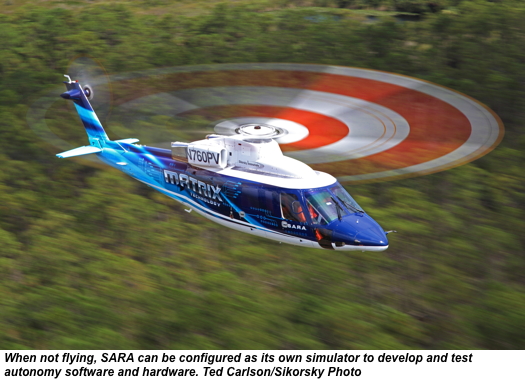
For years, Sikorsky’s executives have described a future in which helicopters will be able to transition between dual-pilot, single-pilot and unmanned flight modes as simply as turning a switch. Despite this early and enthusiastic endorsement of automation, however, Sikorsky has lagged behind other manufacturers in revealing an optionally piloted platform.
This week, Sikorsky is finally ready to show off. The company is using the Association for Unmanned Vehicle Systems International (AUVSI) trade show in Washington, D.C. to unveil a major automation research program called Matrix Technology, along with a test platform — the Sikorsky Autonomous Research Aircraft (SARA) — based on a commercial S-76 helicopter.
According to Sikorsky, SARA is more than just another unmanned helicopter. The company has ambitious goals for its Matrix Technology, with a focus on operations in the low-altitude, obstacle-rich environment where most manned helicopters earn their keep. “The game-changing Matrix Technology we are developing and testing will provide order-of-magnitude improvements in system intelligence and contingency management to ensure high levels of reliability, and ultimately make unmanned missions by helicopters and VTOL [vertical take-off and landing] aircraft of all sizes highly affordable,” said Mark Miller, Sikorsky’s vice president of Research & Engineering.
SARA performed its first autonomy flight with Matrix Technology (with safety pilots on board) on July 26 at Sikorsky’s facilities in West Palm Beach, Fla. According to Chris Van Buiten, vice president of the company’s rapid prototyping organization, Sikorsky Innovations, early test flights have focused on validating performance in hovering and high-altitude maneuvering flight. Subsequent test flights will refine automated take-offs and landings before the flight test program progresses to maneuvering in low-altitude environments — probably near Sikorsky’s facilities in the northeastern United States. “Florida’s ultimately too flat for what we want to do,” Van Buiten explained.

SARA is one of two test platforms in the Matrix Technology program; the other is an optionally piloted UH-60MU Black Hawk with the same proven, fly-by-wire flight controls that were incorporated into the S-76. By the end of next year, the Matrix program aims to demonstrate safe flight in obstacle-rich environments and shipboard and brownout-condition landings, as well as cargo transport using the UH-60MU. Beyond 2014, the program will continue to tackle new challenges, and address customer requirements that further advance autonomy capability for VTOL aircraft.
Van Buiten said that Sikorsky is now about a year-and-a-half into the Matrix Technology program, which is projected to run for a total of four years. That’s similar to the length of Sikorsky’s X2 Technology program, which created a coaxial rotorcraft that in 2010 achieved a top speed of 250 knots in straight-and-level flight. According to Van Buiten, the Matrix program is also similar to the X2 effort in that it is being driven by a “viciously small, highly empowered team” of around 50 people. And, like the X2, it is self-funded, with a budget that Van Buiten said is comparable to the X2 program’s budget of approximately $50 million.
Van Buiten said that safety, reliability and low-altitude capability will be the Matrix program’s key differentiators. “Our legacy has been around products that have a very high reputation for reliability and safety,” Van Buiten said. Whereas loss rates for current unmanned aircraft are estimated at approximately one per 1,000 flight hours, Sikorsky’s Matrix Technology program aims to improve the unmanned aircraft loss rate to one per 100,000 flight hours. However, Sikorsky also expects the Matrix program to yield tangible safety gains for its existing manned platforms, along the lines of the automated rig approach recently developed for the S-92 helicopter. Predicted Miller, “VTOL pilots increasingly will become mission managers, either on the aircraft or when monitoring from the ground via datalink, because they will feel comfortable letting the aircraft fly itself.”









